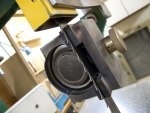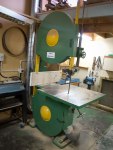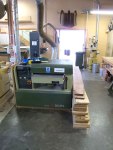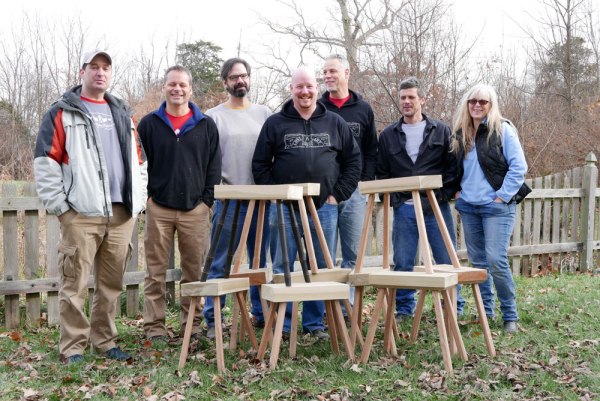Quick Tour of the Melbourne Guild of Fine Woodworking –
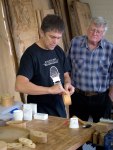
To an American woodworker, the Melbourne, Australia, workshop of Alastair Boell is a place both familiar and strange at the same time.
Boell, a graduate of the North Bennet Street School in Boston, has lots of old American iron in his shop:
• A Tannewitz 36” band saw he bought for $750 from a business closing down. It was in unrestored condition. He pulled the whole thing apart while in Boston. Re-sprayed it. Replaced the bearings and took it apart to get it into the shipping container. Alastair guesses it was built in the 1950s.
• An Oliver 24” patternmaker’s jointer built in 1922 for the American Navy. It even has a Navy yard number stamped on it and its price – $1,933.22.
• Oliver patternmaker’s lathe built in the 1970s. It has 8’ (and a bit) between centers.
What is somewhat strange is all the timber. Alastair has taken an enormous interest in salvaging urban lumber – including lots of species that are hard to get in Australia. So the rafters are packed with all sorts of odd timbers – I don’t know if I’ve ever been in a shop that was filled with such a wide variety of species.
And then there’s all the Australian accents, the upside-down weather and the colorful idioms from the students and Alastair – bless his cotton socks.
All in all, it’s just similar enough to an American shop that you can work comfortably on your own on the machines. But it’s just strange enough that you have really weird Australian-themed dreams.
Alastair and his wife, Jacqueline, run the Melbourne Guild of Fine Woodworking in a light industrial area inside the neighborhood of Box Hill. Box Hill itself adds another layer of surreal for Americans because it’s filled with Asians who all speak with an Australian accent.
The Boells started the school in Box Hill five years ago after returning to Melbourne from the United States. At first, Alastair began working at a nearby not-for-profit school, but after 18 months he left. Then he worked at another not-for-profit school and had a bad experience. He decided to start his own school.
The Melbourne Guild conducts three sorts of classes – open classes, where students bring their own projects. Specialist classes that cover a particular topic. And Masterclass series, where Alastair brings in people such as chairmaker Peter Galbert.
“All the inspiration for all of this is from the United States,” Alastair says. “Everything is emanating from the U.S. at this point – the tools, literature, teachers, revival in hand skills and old machinery.”

In addition to the school, Alastair runs a timber business with a couple other partners that cuts and dries salvaged timbers from neighborhoods, botanical gardens and other urban places.
“I always loved the idea of salvaging timber,” Alastair says. “You can source your own material. Plan your project. Mill your components. Finish it. Use it. Hand it off to your children. The total cycle. There is no other medium I know of that you can have that same journey with.”
The business – Big Sky Timber – is the result of Alastair meeting Pete McCurly, who makes sculpture and has devoted his life to Australian trees.
“When Peter he was a teenager he spent years protesting old-growth logging,” Alastair says. “He lived in a tent. Pete’s very passionate about trees.”
The business came together when Tony, a childhood friend of Alastair, became interested in salvaging urban lumber and invested the money needed to get the business going.
Now if all this seems like a lot to take on for one guy, you’re right. Alastair might be one of the busiest people I’ve ever met.
This morning he was working in the shop on some milling for some bent-laminations. Then he and Pete moved some massive blackwood logs using a crane truck and spent the afternoon positioning a huge hydraulic duplicator lathe. Later he and his family set up for an evening seminar for 50 woodworkers and cleaned up the place afterward into the late hours.

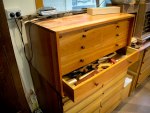
It is, in his own words, a crusade to improve the craftsmanship of his countrymen. What’s obvious is that he has the energy (and family support) to do it. What isn’t as immediately obvious is how highly skilled Alastair is at the bench. The only two testaments to his mastery at the school are his workbench and his tool chest from North Bennet – both fairly low-key objects at first glance. (His graduation project – a stunning and complex Federal piece – is in his bedroom at home.)
While Alastair wasn’t around, I spent some time fiddling with his tool chest, looking at his joints and trying to figure him out through his work. Personally, I think Australia is lucky to have him, and I wish we Americans had been fortunate enough to keep him.
— Christopher Schwarz


